
The basque company SK10, which works in the integration of aeronautical structures, has given a significant step forward in its innovation range within compound materials of carbon fibre.
Recently, SK10 has signed with the company EADS-CASA a contract for the development, industrialisation and subsequent mass production of the leading edges of the horizontal stabiliser for the new aircraft Falcon F7X, of the French company DASSAULT.
The development of horizontal stabiliser
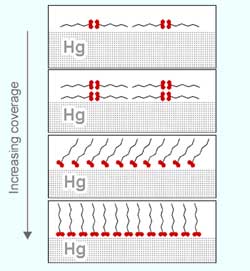
A team of scientists from the U.S. Department of Energy’s Brookhaven National Laboratory, Harvard University, and Bar-Ilan University in Israel have grown ultrathin films made of organic molecules on the surface of liquid mercury. The results, reported in the November 15, 2002, issue of Science, reveal a series of new molecular structures that could lead to novel applications in nanotechnology, which involves manipulating materials at the atomic scale.
Growing molecular films on liquid

The success of many advanced technologies that use devices such as sensors and actuators, including gyroscopes and optical devices, depends on microscopic components called microelectromechanical systems (MEMS) devices made of polycrystalline silicon (polysilicon). Researchers at Case Western Reserve University report in the November 8 issue of Science that miniature micron-sized polysilicon laboratory specimens subjected to cyclic tension/compression loading undergo fatigue, and could ultimately fa
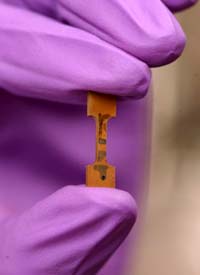
Extreme cold and high heat help optimize the metal’s microstructure
Combining old-fashioned metal-working techniques with modern nanotechnology, engineers at The Johns Hopkins University have produced a form of pure copper metal that is six times stronger than normal, with no significant loss of ductility.
The achievement, reported in the Oct. 31 issue of the journal “Nature,” is important because earlier attempts to strengthen a pure metal such as copper have almost always
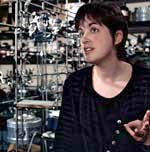
Dolphins, long considered the second-smartest species on the planet, recognize one another by name, possess a distinct concept of “self’ and, it turns out, have some surprisingly good ideas about techniques for keeping the hulls of maritime ships clean.
Karen L. Wooley, Ph.D., professor of chemistry at Washington University in St. Louis, has noted the shape and texture of dolphin skin and how it naturally prevents marine creatures from clinging to dolphin skin. The observation fits into h
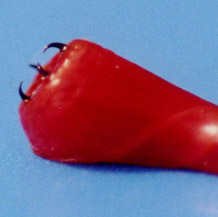
Researchers report in the Oct. 11 “Science” the first detection of a living organism that makes a copper-containing mineral structure as part of its skeleton. The finding is remarkable because the amount of copper detected in the jaw tip of the marine bloodworm would normally be toxic to an organism.
The researchers determined that copper also occurs in non-mineral form in the bloodworm jaw where it may act as a structural element in cross-linking long chains of fibrous proteins. According

A process developed at Ohio State University for shaping metal parts using magnetism has reached a new milestone — one that may cut manufacturing costs and help preserve the environment.
The process could also expand manufacturers’ choice of available metals, and enable the use of aluminum parts in lighter, fuel-efficient automobiles.
Glenn S. Daehn, professor of materials science and engineering, and his colleagues pioneered hybrid electromagnetic metal forming in 1999, while col

Applications include nanotechnology, more
Defects such as cracks in a material are responsible for everything from malfunctioning microchips to earthquakes. Now MIT engineers have developed a model to predict a defect’s birthplace, its initial features and how it begins to advance through the material.
The model could be especially useful in nanotechnology. “As devices get smaller and smaller, understanding the phenomena of defect nucleation and growth becomes more and more

The technology centre GAIKER of the Basque Country is working on a project whose aim is to develop intelligent polymers and discover their opportunities. Similarly, it will study the possibilities to introduce those polymers in the existing structures in order to promote their applicability and to create new enterprise initiatives.
GAIKER researches in polymers the elaboration and transformation of intelligent materials. For that aim, it develops its own technologies and then adjust them to

To make super-durable and strong details it is necessary to use so-called diamond composites, i.e. materials (matrixes) with incorporated tiny diamonds. The matrix is to be durable, strong, wear-proof as well as monolithic by structure ensuring chemical interaction with diamonds. To avoid internal tension this matrix must have physical characteristics close to diamond ones. In other case the detail will collapse under load.
Carbide materials fit all these requirements because they are strong
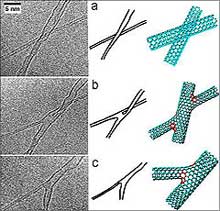
Researchers have discovered how to weld together single-walled carbon nanotubes, pure carbon cylinders with remarkable electronic properties. The discovery could pave the way for controlled fabrication of molecular circuits and nanotube networks.
Pulickel Ajayan, professor of materials science at Rensselaer Polytechnic Institute in Troy, N.Y., and his colleagues in Germany, Mexico, the U.K., and Belgium used irradiation and heat to form the welded junctions.
This is the first time

Accident Leads to Important Discovery
Researchers at Rensselaer Polytechnic Institute in Troy, N.Y., have created large symmetrical crystals that rarely occur in nature. These crystals could be harder than conventional engineering materials. The accidental discovery was made during attempts to make superconducting nanostructures with a simple technique used to create carbon nanotubes.
Pulickel Ajayan and Ganapathiraman Ramanath, faculty members in materials science and eng

Researchers say they have developed the world’s strongest, lightest solids. Called aerogels, the sturdy materials are a high-tech amalgam of highly porous glass and plastic that is as light as air.
#In light of the events of Sept. 11 and a heightened interest in homeland security, these new materials show promise as lightweight body armor for soldiers, shielding for armored vehicles, and stronger building materials, the researchers say.
The materials could also be used for better

There may well be a plastic biochip in your future, thanks in part to the National Institute of Standards and Technology (NIST).
Microfluidics devices, also known as “lab-on-a-chip” systems, are miniaturized chemical and biochemical analyzers that one day may be used for quick, inexpensive tests in physicians’ offices. Most microfluidics devices today are made of glass materials. Cheaper, disposable devices could be made of plastics, but their properties are not yet well understood.

The hassle of removing and cleaning your contacts every night, or even every month, could become a thing of the past, based on a study involving a new contact lens coating that kills bacteria.
The study involved rabbits. The coating: an extremely thin layer of selenium, a naturally occurring element found in soil, some plants and many foods we eat.
The rabbits showed no ill effects after two consecutive months of wearing the coated lenses, according to Ted Reid, Ph.D., of Texas Te

A new way to assemble complex, three-dimensional structures from specially formulated colloidal inks could find use in advanced ceramics, sensors, composites, catalyst supports, tissue engineering scaffolds and photonic materials.
As will be reported in the July 9 issue of the journal Langmuir, scientists have developed colloidal, gel-based inks that form self-supporting features through a robotic deposition process called robocasting. A computer-controlled robot squeezes the ink out of a s